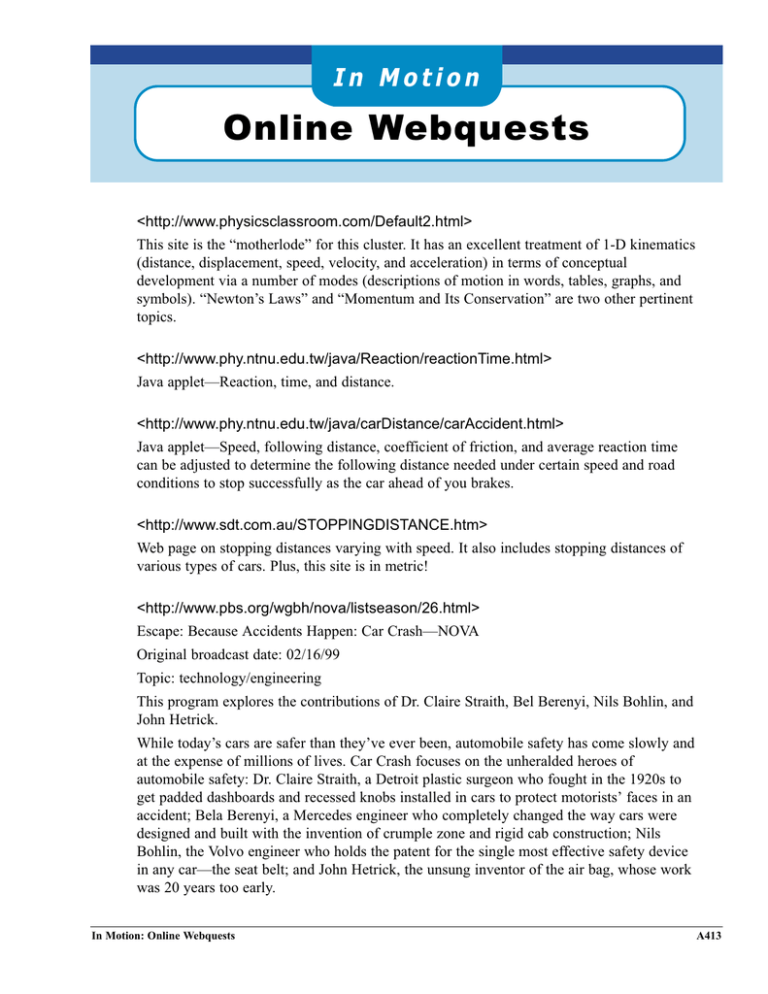xx. Webquests (web).qxd
advertisement

In Motion Online Webquests <http://www.physicsclassroom.com/Default2.html> This site is the motherlode for this cluster. It has an excellent treatment of 1-D kinematics (distance, displacement, speed, velocity, and acceleration) in terms of conceptual development via a number of modes (descriptions of motion in words, tables, graphs, and symbols). Newtons Laws and Momentum and Its Conservation are two other pertinent topics. <http://www.phy.ntnu.edu.tw/java/Reaction/reactionTime.html> Java appletReaction, time, and distance. <http://www.phy.ntnu.edu.tw/java/carDistance/carAccident.html> Java appletSpeed, following distance, coefficient of friction, and average reaction time can be adjusted to determine the following distance needed under certain speed and road conditions to stop successfully as the car ahead of you brakes. <http://www.sdt.com.au/STOPPINGDISTANCE.htm> Web page on stopping distances varying with speed. It also includes stopping distances of various types of cars. Plus, this site is in metric! <http://www.pbs.org/wgbh/nova/listseason/26.html> Escape: Because Accidents Happen: Car CrashNOVA Original broadcast date: 02/16/99 Topic: technology/engineering This program explores the contributions of Dr. Claire Straith, Bel Berenyi, Nils Bohlin, and John Hetrick. While todays cars are safer than theyve ever been, automobile safety has come slowly and at the expense of millions of lives. Car Crash focuses on the unheralded heroes of automobile safety: Dr. Claire Straith, a Detroit plastic surgeon who fought in the 1920s to get padded dashboards and recessed knobs installed in cars to protect motorists faces in an accident; Bela Berenyi, a Mercedes engineer who completely changed the way cars were designed and built with the invention of crumple zone and rigid cab construction; Nils Bohlin, the Volvo engineer who holds the patent for the single most effective safety device in any carthe seat belt; and John Hetrick, the unsung inventor of the air bag, whose work was 20 years too early. In Motion: Online Webquests A413 Appendix 7: In MotionTeacher Resource Guide Senior 2 Science <http://www.pbs.org/wgbh/nova/transcripts/2605car.html> This site has the transcript of the program Escape: Because Accidents Happen: Car Crash. <http://www.pbs.org/wgbh/nova/escape/timecar.html> A great site for a description of the contributions of Dr. Claire Straith, Bela Berenyi, Hans Bohlin, and John Hetrick. <http://www.pbs.org/wgbh/nova/escape/resourcescar.html> A host of student resources and activities concerning car safety. <http://www.riccilegal.com/FSL5CS/articles/articles31.asp> A history lesson on the evolution of the seat belt and the resistance of the automobile manufacturers to adopt their installation in vehicles. <http://www.nader.org/history_bollier.html> This site contains a book outlining a history of Ralph Naders contributions to the automobile safety and consumer movements in the United States. <http://www.womanmotorist.com/sfty/index-safety-airbags.shtml> This site is all about air bags. <http://www.nhtsa.dot.gov/> This is the United States government site for traffic safety. Check out the links to videos showing car crashes and the resulting second collisions of anthropometric dummies with the interior of the vehicle. It has videos of all sorts of situations. This site has it all: statistics, ratings of cars, research, and much more. <http://www.tc.gc.ca/road/menu.htm> This is the Transport Canada site for road transportation safety. <http://www.netsoc.dit.ie/~ncolgan/phe/n2law.htm> Newtons Second Law applet. Students can vary the mass of the car being accelerated or the mass of the hanging mass used to accelerate the cart. The mass under acceleration by the hanging mass is the mass of the cart PLUS the mass of the hanging mass. <http://www.netsoc.dit.ie/~ncolgan/> A site with a lot of applets, mostly those by W. Fendt. A414 In Motion: Online Webquests Senior 2 Science Appendix 7: In MotionTeacher Resource Guide <http://www.cs.uleth.ca/students/berdine/> This site has Newtons Cradle demonstrating a number of different motions, including one sphere released from each side. <http://www.walter-fendt.de/ph14e/> This site has the latest updated applets from Walter Fendt. These can be downloaded and run from computers without an Internet connection simply by using the browser. <http://www.physics.gatech.edu/academics/Classes/summer2002/2211/main/demos/> This is a compilation of many applets from different sources. There is a particularly good one on distance versus displacement. This also has applets for In Motion with constant acceleration, Newtons Second Law, Newtons Cradle, and conservation of momentum with an astronaut tossing a ball in space. <http://www.visualexpert.com/Resources/reactiontime.html> This site (www.visualexpert.com) has a host of information on human perception, especially visual, and the factors that affect this. The information is applied to humans as drivers. <http://www.nhtsa.dot.gov/people/outreach/traftech/pub/tt201.html> The effect of the combination of alcohol and marijuana on the reaction time of drivers is detailed here. This would be a good site for the Chapter 7 case studies. <http://www.nsc.org/library/shelf/inincell.htm> The results of a study Does Cell Phone Conversation Impair Driving Performance? In Motion: Online Webquests A415 Appendix 7: In MotionTeacher Resource Guide Senior 2 Science Notes A416 In Motion: Online Webquests





